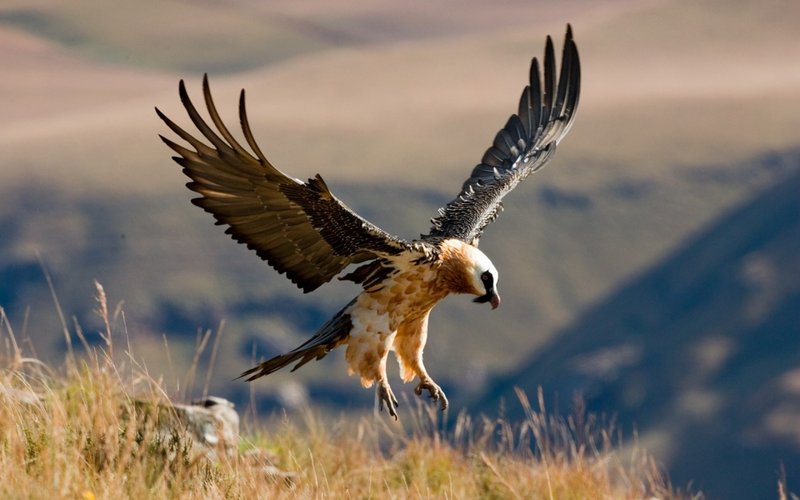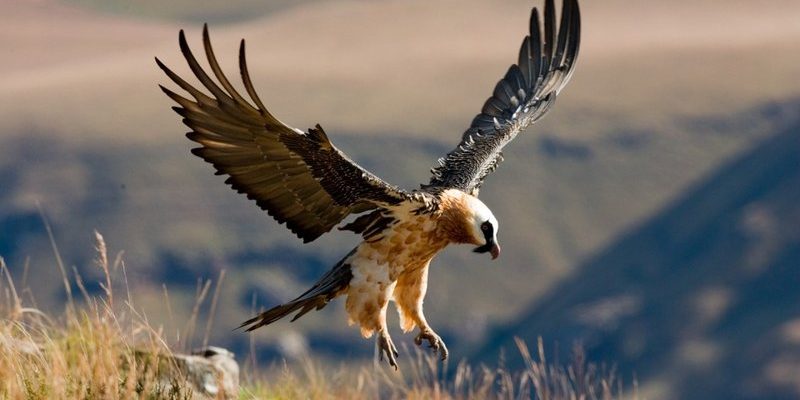
Let’s dive deeper into the unique ways vultures hunt and soar through the skies. Imagine you’re sipping your coffee and glancing at the vast horizon, and suddenly, a vulture glides effortlessly on the wind, scanning the ground below. How do they do that? What sets them apart from other birds? Well, buckle up because we’re about to explore the incredible world of vultures!
How Vultures Soar Like Pros
Vultures have a remarkable ability to soar and glide for long distances without flapping their wings much. This technique is all about thermals—rising columns of warm air. When the sun heats the ground, pockets of air warm up and begin to rise. Vultures take advantage of this.
Think of thermals as invisible highways in the sky. Vultures can ride these currents, gaining altitude with minimal effort. Imagine a kite catching the wind—it’s a similar concept! Instead of constantly flapping their wings, vultures can often stay aloft for hours, covering vast areas in search of food.
Their wings are uniquely designed for this skill. Vultures have broad, sturdy wings that allow for stability while soaring. These adaptations help them conserve energy and remain in the air longer. So, next time you see one soaring overhead, remember they’re not just flying; they’re riding the currents like seasoned pilots!
The Art of Scavenging
Vultures are experts at finding food, and their hunting techniques reflect that. They typically don’t kill their prey; instead, they locate carrion—dead animals. But how do they sniff out meals when they often fly high above the ground?
Well, vultures have an exceptional sense of smell, which is quite rare among birds. In fact, they can detect the scent of decaying flesh from miles away! That’s right—while other birds may rely on sight, vultures have the olfactory skills to track their next meal.
This keen sense of smell leads them to areas where their scavenging skills can shine. Once they spot potential carrion, vultures work together, socializing and communicating to alert others in their group. It’s a bit like a team of detectives, using their noses to solve the mystery of where the food is!
Unique Feeding Behaviors
When vultures arrive at a food source, they exhibit some fascinating behaviors. First off, they’re not the only ones interested in that meal. Other scavengers, from smaller birds to mammals, might also be eyeing the same feast. This is where vulture hierarchy comes into play.
Larger vultures tend to dominate dining spots. They’re more aggressive and have the physical heft to push smaller scavengers aside. But don’t worry; they’re not all thugs. Vultures often wait their turn, allowing smaller birds to eat first. This communal behavior helps maintain the ecosystem’s balance.
When it’s their turn, vultures use their strong beaks to tear apart tough hides and access the meat. Their digestive systems are specially adapted, allowing them to consume bacteria-laden flesh without getting sick. Imagine having the stomach of a garbage disposal—that’s what enables them to thrive on carrion!
Adaptations for Survival
You might be wondering why vultures can thrive in environments where most other animals would struggle. It all boils down to a series of incredible adaptations. For starters, their bald heads are more than just a quirky look; this feature helps them stay clean. When they dive into a carcass, feathers would trap bacteria and parasites, but a bare head is easier to keep sanitary!
Additionally, vultures have powerful digestive systems that allow them to safely process decaying food. Their stomachs can kill off harmful bacteria, which helps them avoid diseases that could be fatal to other animals. This adaptation not only helps them survive but also makes them crucial for the environment by cleaning up dead animals.
Overall, these adaptations ensure that vultures fulfill their ecological role effectively. Without them, carcasses would accumulate, potentially spreading disease and imbalance throughout their habitats.
Social Structures and Relationships
Despite their solitary appearance while soaring in the sky, vultures are quite social creatures. They often gather in groups, especially when feeding, which creates a unique social dynamic. You might call this a “family reunion” of sorts, as vultures rely on one another for various activities.
In these groups, there’s a clear hierarchy based on size, age, and strength. Young vultures learn from older, more experienced ones, gaining valuable skills in scavenging and survival. It’s like an apprenticeship in the wild, where they observe and mimic behaviors.
Here’s the thing: this social structure helps vultures thrive in their environment. By working together, they improve their chances of survival and ensure that they can find food more efficiently. They communicate through various vocalizations, signaling danger or calling others to a food source, showcasing a highly developed level of social interaction.
The Impact of Vultures on Ecosystems
You might not think about vultures much, but they play a vital role in our ecosystems. As nature’s clean-up crew, their scavenging habits help prevent the spread of disease. By consuming dead animals, they eliminate potential breeding grounds for pathogens.
Their presence is crucial in maintaining biodiversity. For instance, populations of vultures help keep the number of other scavengers in check, ensuring the ecosystem remains balanced. When vultures are removed from an ecosystem, it can lead to an overpopulation of other scavengers, which may create further imbalances.
Furthermore, vultures contribute to nutrient cycling. When they consume carrion, they help break down organic matter, returning nutrients to the soil. This process supports plant growth, which is essential for the health of their habitats.
Conservation Challenges
Despite their importance, vultures face significant threats worldwide. Habitat destruction, poisoning, and hunting contribute to declining populations. You might wonder how something so vital could be at risk.
One major issue is poisoning—often, livestock farmers use poisons to kill predators. Unfortunately, vultures often consume the carcasses of these poisoned animals, leading to unintended deaths. This practice not only endangers vultures but disrupts the ecological balance they help maintain.
Additionally, habitat loss due to urban development and agriculture reduces their living space. Conservation efforts are in place to try to protect these remarkable birds. Awareness campaigns and protective legislation are essential to ensuring that vultures can continue their essential work in nature.
In summary, vultures are more than just birds that eat dead animals. Their unique flying and hunting techniques, along with their critical role in the ecosystem, highlight their importance. As we go about our lives, let’s remember how much these remarkable creatures contribute to our world. Protecting them is not just about saving a species; it’s about preserving the balance of nature itself.
So, the next time you spot a vulture soaring above, appreciate the artistry in how it hunts and survives. Knowing the unique flying and hunting techniques of the vulture might just make you look at these majestic birds in a whole new light.

